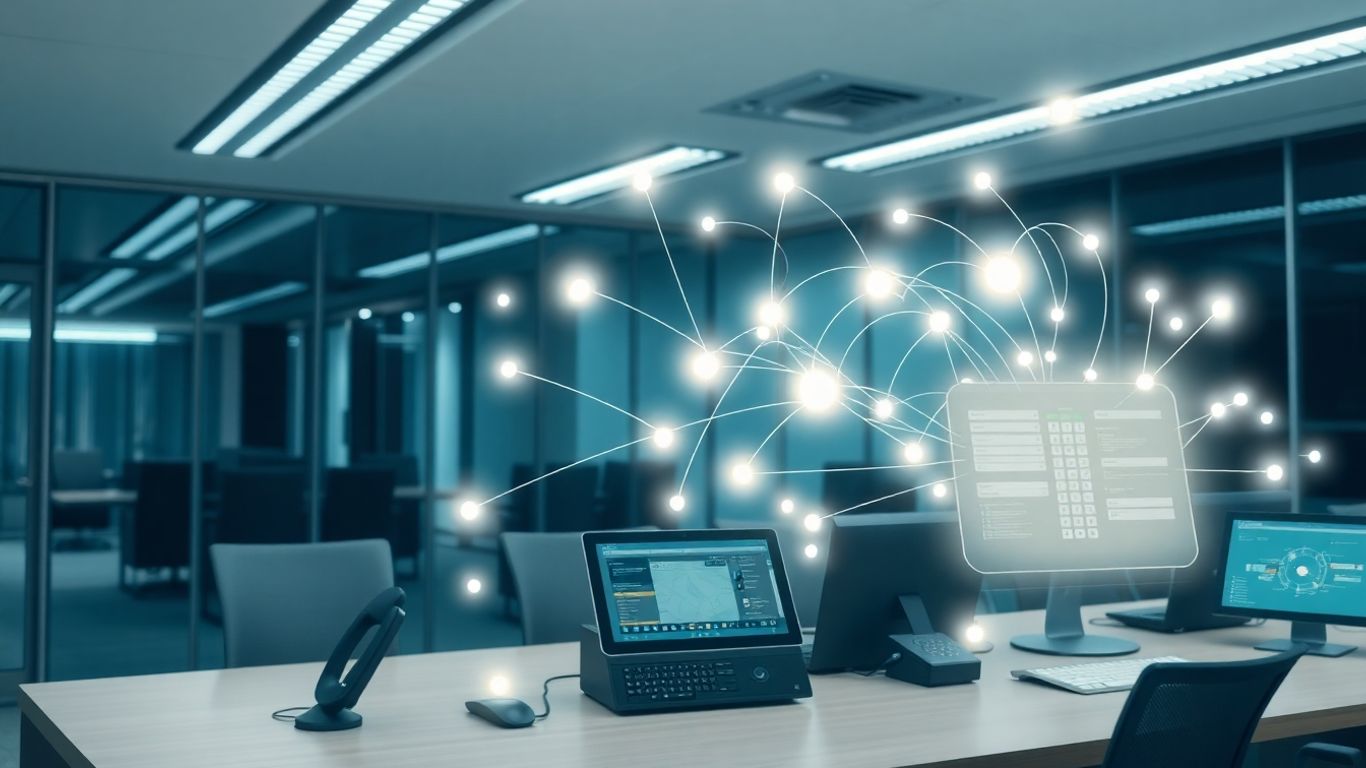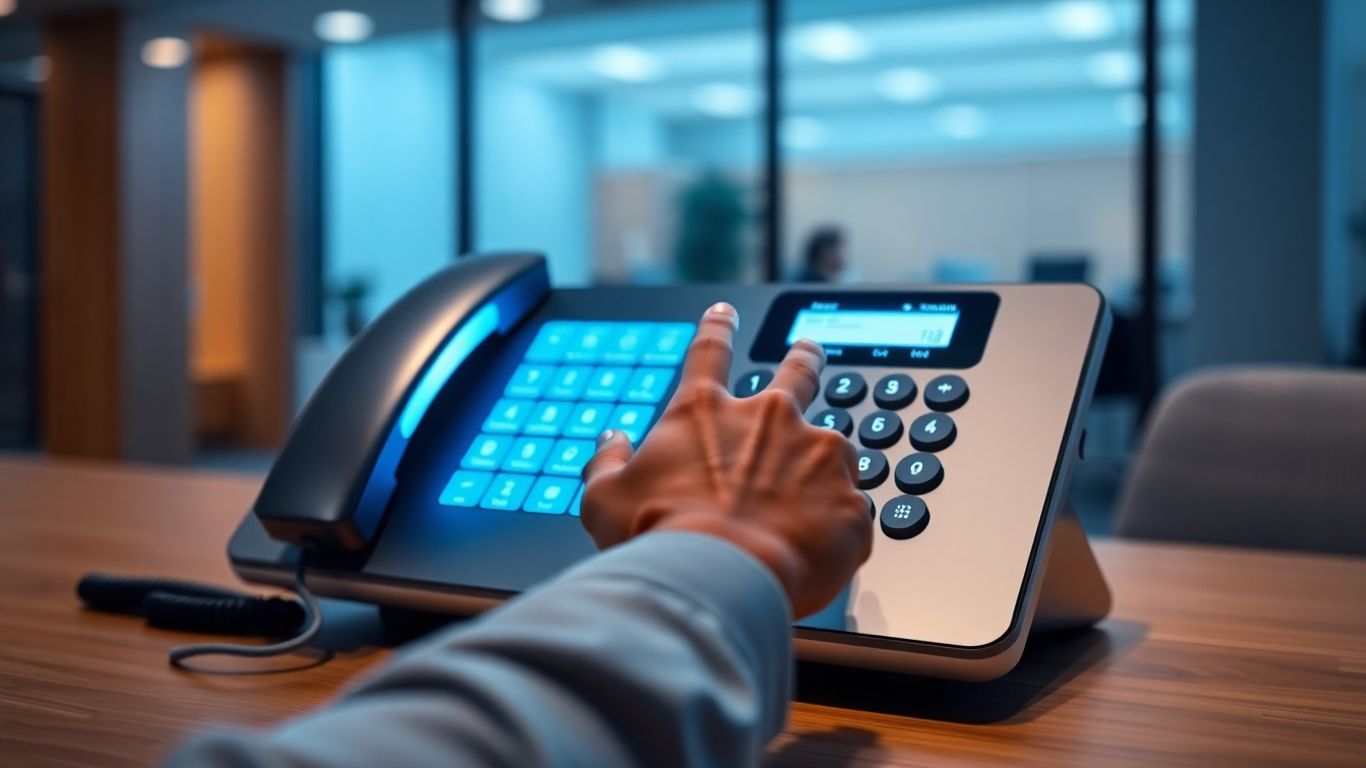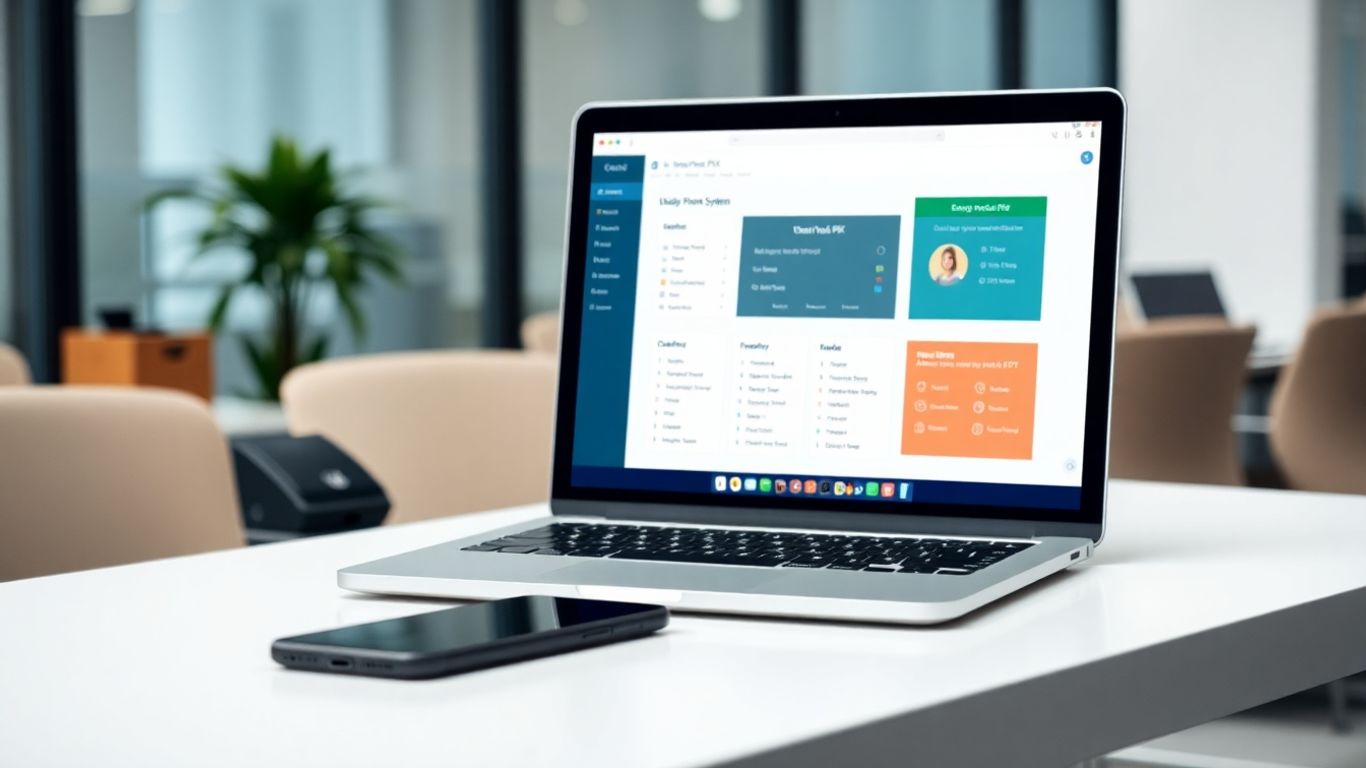Dealing with phone calls can get messy, right? You've got customers calling, and you need to make sure they get to the right person without a long wait. That's where a virtual PBX phone system auto attendant really shines. It's like having a super-organized greeter for your business, working around the clock. No more missed calls or frustrated customers stuck on hold. Let's talk about how this simple tool can make a big difference in how your business runs.
In today's busy world, how your business handles phone calls can really make or break a customer's impression. It's not just about picking up the phone; it's about how smoothly and professionally you guide callers to where they need to go. This is where an auto attendant really shines. Think of it as your digital receptionist, always ready to help.
An auto attendant takes the guesswork out of directing calls. Instead of a person having to manually transfer every single inquiry, the system does it for you. This means fewer dropped calls and less waiting around for callers. It's all about making things efficient from the moment the phone rings.
When callers hear a clear, automated greeting and a well-organized menu, it signals that your business is organized and takes customer service seriously. This professional touch builds trust. Plus, by automating the initial call handling, your human staff can focus on more complex issues, making everyone more productive.
A well-designed auto attendant acts as the first point of contact, setting a positive tone and ensuring callers feel heard and directed appropriately, even outside of business hours.
This is the core benefit. Callers can use their keypad or even voice commands to select options that lead them directly to the person or information they need. Whether it's sales, support, or a specific department, the auto attendant handles the initial routing. This frees up your team to do what they do best, without getting bogged down by constant call transfers. It's a smart way to manage incoming calls and keep your business running smoothly.
Think about how many times you've called a business and been met with a confusing menu or a long wait. It's not a great feeling, right? A virtual PBX with an auto attendant feature can really change that experience for your customers. It's like having a super-organized receptionist who's always on duty.
This is where the magic happens. Instead of a person having to answer every single call and figure out where it needs to go, the auto attendant does it automatically. You set up a system of options, and callers press a number or say a word to get to the right place. This means fewer dropped calls and less time wasted by your staff.
Having an auto attendant makes your business sound more put-together. It shows you've thought about how to handle calls efficiently. This isn't just about sounding good; it's about making things work better. When calls are routed correctly the first time, it saves everyone time and reduces frustration. It's a simple way to make your business look and operate more professionally.
A well-designed auto attendant can significantly cut down on the time your team spends managing incoming calls. This allows them to dedicate more energy to tasks that directly contribute to business growth and customer satisfaction.
If you have a receptionist, this feature is a lifesaver. Instead of them being bogged down with basic call routing, they can handle more complex tasks. This could be anything from managing schedules to assisting with customer issues that actually require a human touch. It helps prevent burnout and makes their job more fulfilling. It's a smart way to manage your human resources better.
Let's be honest, time is money. By automating the initial stages of call handling, you're saving both. You save the time your employees would spend on routing calls, and you save the resources that might go into hiring extra staff just for phone duties. This efficiency boost can be reinvested into other areas of your business, like marketing or product development. It's a practical way to get more done with less.
Consider how an automated system can help manage your customer interactions. For instance, an AI chatbot can handle website visitors, turning them into leads and syncing with your CRM, which can lead to more inbound leads. Learn about AI chatbots.
Also, think about outbound calls. An AI-powered outbound phone agent can automate tasks like lead qualification or sending reminders, launching thousands of personalized calls in minutes. Explore AI outbound agents.
When someone calls your business, the last thing they want is to get stuck in a confusing phone tree. It’s like trying to find your way through a maze blindfolded. Our virtual PBX system helps you avoid that frustration by making your automated greetings super clear. You get to set up menu options that are easy to understand, so callers can quickly get to where they need to go. Think about it: instead of a long list of choices, you offer just a few, well-thought-out options. This makes the whole process smoother for everyone involved.
First impressions really do matter, right? The way your business sounds on the phone can say a lot. With our auto attendant, you can use professional voice recordings for your greetings and menu options. This isn't just about sounding good; it's about showing callers you're serious about your business and their experience. It makes your company seem more established and trustworthy, which is a big plus, especially for smaller businesses trying to make their mark. A polished greeting can really set a positive tone from the very start of the interaction.
Your business doesn't always operate on a 9-to-5 schedule, and neither do your customers. That's where the 24/7 availability of an auto attendant really shines. Even when your office is closed, your phone system is still working. It can greet callers, provide basic information like store hours or directions, or take messages. This means no one has to miss out on connecting with you just because it's after hours. It’s like having a receptionist who never sleeps, always ready to guide your callers or at least let them know you'll get back to them.
Automated greetings aren't just a convenience; they're a strategic tool for managing caller expectations and directing them efficiently, even outside of business hours. This consistent availability builds trust and ensures that potential opportunities aren't lost due to simple timing issues.

Your virtual PBX can do more than just take calls. Imagine your phone system talking directly to your calendar. When a customer calls and wants to book an appointment, the auto attendant can check your availability in real-time and book it directly. No more back-and-forth emails or missed calls leading to lost business. This kind of connection means fewer scheduling errors and happier customers who get the time slot they want, right when they want it.
Sometimes, a quick text is better than a call. Your auto attendant can be set up to send automated text messages based on certain call triggers. For example, after a customer calls to confirm an appointment, the system could automatically send them a text reminder a day before. This keeps people informed without you lifting a finger and can really cut down on no-shows. It's a simple way to add a personal touch and make sure important information gets across.
Voicemails don't have to be a black hole of missed messages. With AI-powered voicemail, messages are automatically transcribed into text. This means you can quickly read through your messages instead of listening to each one. The system can even sort them or flag urgent ones. It’s like having a super-efficient assistant who listens to every message and gives you the highlights, saving you a ton of time and making sure you don't miss anything important.
Think about it – not every call needs the same treatment, right? Your business has specific hours, and sometimes, you only want your automated system to be active during those times. With a virtual PBX, you can set exactly when your auto attendant is on duty. This means no more "Sorry, we're closed" messages popping up during your actual business hours. It's about making sure callers reach the right place, at the right time, every time.
What happens when it's a public holiday, or a caller is in a completely different time zone? Your auto attendant can handle that. You can program it to recognize these special dates or different time zones and adjust its greetings and routing accordingly. So, instead of a generic greeting, a caller might hear, "Happy Thanksgiving! Please leave a message, and we'll get back to you tomorrow," or get directed to an international line if they're calling from overseas.
This is where things get really smart. The system doesn't just answer calls; it understands the context. A call coming in on a Friday afternoon might get a different initial message than one that comes in on a Monday morning. It can tailor responses based on the day, the time, or even specific events you've programmed. This level of detail makes the caller feel understood and shows your business is paying attention to the little things that matter.

Think about all the different tools your business uses every day. You've got your customer relationship management (CRM) software, your scheduling apps, maybe some project management tools, and on and on. It can feel like a lot, right? What if your phone system could actually talk to all of them? That's where smart integrations come in, and they can really change how smoothly things run.
It sounds like a lot, and honestly, it kind of is. A virtual PBX system with good integration capabilities can connect with thousands of other apps. We're talking about everything from the big names you probably use, like Salesforce or Google Calendar, to more niche tools your team might rely on. This means your phone system isn't just sitting there on its own; it's part of your whole digital ecosystem.
This is where it gets really interesting. It's not just about sending information one way. Imagine this: a customer calls, your auto attendant routes them, and when the call ends, the system automatically updates their contact record in your CRM. But it goes both ways. If you update a customer's info in your CRM, that information can be pulled into your phone system for the next interaction. It’s like having a constant, automatic update happening in the background, so everyone has the latest info.
This is the real game-changer for efficiency. Let's say your auto attendant identifies a caller needs to schedule a follow-up. Instead of someone having to manually create a task or send an email, the system can be set up to do it automatically. It can trigger a notification to a specific team member, create a new task in your project management tool, or even send a follow-up text message to the caller. These automated actions save a ton of time and cut down on the chances of human error. It means your team can focus on more important things instead of repetitive data entry or manual follow-ups.

It’s easy to get carried away with new tech, right? You want all the bells and whistles, but then the bill comes, and suddenly you’re wondering where all that money went. That’s where managing how you use your virtual PBX system really comes into play, especially with features like the AI receptionist. You don't want to spend a fortune on something that's supposed to save you money.
This is a pretty straightforward way to keep your spending in check. You can actually set a limit on how many minutes your AI receptionist can be active within a certain timeframe – think daily, weekly, or monthly. It’s like putting a cap on your usage before it gets out of hand. This helps you budget better and avoid those surprise charges that can pop up if the AI is running more than you expected.
Setting these limits isn't about restricting your service; it's about smart financial planning. It ensures that the AI receptionist works within your budget, providing support without breaking the bank.
Knowing what’s happening as it happens is a big deal. With real-time monitoring, you can see exactly how many minutes your AI receptionist has handled. This visibility is key. If you notice usage is spiking unexpectedly, you can investigate why. Maybe there’s a specific campaign driving more calls, or perhaps a particular time of day sees a surge. Understanding these patterns helps you optimize your settings and your overall call strategy.
So, what happens when you hit that maximum minute limit you set? That’s where overflow options come in. Instead of calls just getting dropped or the AI stopping mid-sentence, you can set up what happens next. Maybe calls get automatically forwarded to a live agent, sent to voicemail, or even trigger a text message to your team. This way, even when you’re at your limit, your callers still get directed somewhere helpful, and you don’t miss out on important communications. It’s a safety net that keeps things running smoothly, no matter what.
Remember the days when a busy signal was a common frustration for both businesses and their customers? It felt like you were constantly hitting a wall, unable to connect because all the phone lines were tied up. That's a thing of the past with a virtual PBX system.
This system is built to handle a massive amount of calls all at once. Think of it like a highway with an endless number of lanes – no matter how many cars (or calls) are trying to get through, there's always space. This means your business can take on a huge volume of inquiries without breaking a sweat. It's a game-changer for businesses that experience sudden spikes in call volume or just have a lot of customers trying to reach them.
No more hearing that annoying busy tone! When your auto attendant is powered by a virtual PBX, it can manage countless calls simultaneously. Customers get connected to the automated system or a live agent without delay. This dramatically improves the customer experience because they don't have to wait around hoping for a line to open up. It makes your business look more professional and accessible, which is always a good thing.
What happens when your business suddenly gets a lot bigger, or you launch a new product that gets everyone talking? With a traditional phone system, you'd be scrambling to add more lines, which is expensive and time-consuming. A virtual PBX, however, scales automatically. Need to handle 100 calls at once? No problem. Need to handle 1,000? It's ready. This flexibility means you're never caught off guard, and you can grow your business without worrying about your phone system holding you back. It's like having a phone system that grows with you, no matter what.
Think about the last time you called a company and got a slow, robotic response. Frustrating, right? That's exactly what we've worked to eliminate. Our virtual PBX system's auto attendant is built for speed. We measure its response time in milliseconds. That's quick enough to keep up with natural conversation, making sure your customers don't feel like they're talking to a machine.
Speed matters in conversation. A slow response can disrupt the natural flow, making the interaction feel awkward or even annoying. Our system is designed to be incredibly fast, responding almost instantly. This means the conversation feels more natural and less like a series of delayed commands.
When a system responds quickly, it keeps the conversation moving smoothly. It's like having a dance partner who's always in step. This speed isn't just a technical detail; it's key to creating a positive customer experience. Instead of waiting for a response, callers can get the information or help they need without interruption.
This rapid response capability transforms how customers interact with your business. It moves beyond just answering calls to creating a more engaging and efficient experience. Customers feel heard and helped quickly, which can make a big difference in their overall perception of your brand. It's about making every interaction feel effortless and professional.

Think about all the little tasks that eat up your day. You know, the ones that involve copying information from one place to another, or manually triggering the next step in a process. It’s easy to get bogged down in that stuff. That’s where Zapier comes in. It’s like a digital connector that lets your virtual PBX and other apps talk to each other. So, when a call comes in, or a message is left, Zapier can automatically do something else for you. Maybe it adds a new contact to your CRM, or creates a task in your project management tool. This means less manual work and more time for what actually matters.
Nobody likes typing the same information over and over. It’s boring, it’s time-consuming, and honestly, it’s a great way to make mistakes. With Zapier, you can set up automations so that data flows directly between your phone system and your other business software. For example, when a new lead calls, their information can be automatically added to your customer relationship management (CRM) system. No more typing names, numbers, or emails by hand. This keeps your data clean and your team focused on actual selling or customer service, not data entry.
When your different business tools aren't talking to each other, things get messy. Information gets lost, tasks get missed, and your team might not have the full picture. Zapier helps fix that by creating a connected ecosystem. Imagine this: a customer calls, your virtual PBX records the interaction, and Zapier automatically updates their record in your CRM, adds a note to your project board, and even sends a follow-up email template. Everything stays up-to-date across the board, so everyone is working with the latest information. It makes your whole operation run much smoother, like a well-oiled machine.
Make your daily tasks run smoother by connecting your favorite apps. Our system works seamlessly with tools like Zapier, automating the way you handle business. Ready to see how easy it can be? Visit our website to learn more and get started today!
So, there you have it. A virtual PBX with an auto attendant isn't just about answering calls; it's about making your business run smoother. Think about it – fewer dropped calls, happier customers getting to the right place faster, and your team getting to focus on what they do best. It’s a pretty simple idea, really. Setting one up might seem like a big step, but honestly, it’s more about making things easier in the long run. Give it a shot, and you might be surprised how much of a difference it makes.
Think of an auto attendant as a friendly robot receptionist for your business phone. When someone calls, instead of a person answering, the auto attendant picks up and offers a menu of options, like 'Press 1 for sales' or 'Press 2 for support.' It helps guide callers to the right place without needing a live person to answer every single call.
An auto attendant makes your business sound organized and efficient. It offers callers a clear path to what they need, showing you've put thought into how you handle calls. Plus, with professional voice recordings, it sounds much more polished than just a basic voicemail.
Absolutely! Auto attendants can be set up to work 24/7. You can program them to give out information like holiday hours or direct urgent calls to an on-call person, even if it's late at night or on a weekend.
Definitely. By handling common questions and directing calls automatically, the auto attendant frees up your receptionist to focus on more important tasks that require a human touch, like complex customer issues or administrative work.
It saves time by quickly getting callers to the right department, cutting down on how long people wait. It saves money because you might not need as many people answering phones, and your existing staff can be more productive.
Yes, you can totally customize it! You decide what options callers see and hear. You can set it up with as many or as few choices as you need, and you can change them anytime your business needs change.
No problem! You can set up 'overflow' options. This means if a caller can't find what they need, or if they select an option that requires a person, the call can be sent to a live person, to voicemail, or to another designated number.
These systems are super fast! They respond in milliseconds, which is quicker than you can blink. This speed helps conversations feel natural and prevents callers from getting frustrated waiting for the system to catch up.
Start your free trial for My AI Front Desk today, it takes minutes to setup!








